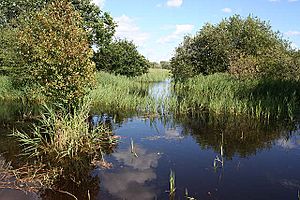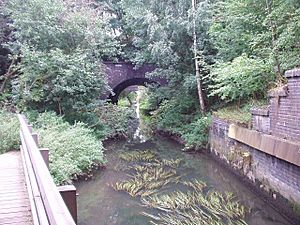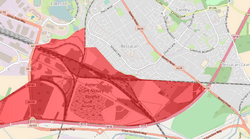Potteric Carr facts for kids
Quick facts for kids Potteric Carr |
|
|---|---|

|
|
| Lua error in Module:Location_map at line 420: attempt to index field 'wikibase' (a nil value). | |
| Location | Yorkshire, England |
Potteric Carr is a huge natural area located southeast of Doncaster in Yorkshire, England. It's bigger than 3,000 acres (about 12 square kilometers) and is a really important place for wildlife.
Contents
A Look Back: Potteric Carr's Past
Potteric Carr has changed a lot over hundreds of years. Imagine what it was like long ago!
How Potteric Carr Looked in the 1500s
One of the first mentions of Potteric Carr was around 1540 by a traveler named Leland. He described passing a brook called Rossington Bridge near Doncaster. The land around Doncaster had good meadows, farms, and some woods.
Leland saw a landscape very different from today. Sherwood Forest stretched almost to Doncaster. Huge, old oak trees dotted the land from Bawtry to Hatfield. To the west of the road, Leland saw a "largely impenetrable morass of bog and fen." This was Potteric Carr, a wild, marshy area. To the east, he saw similar wet, marshy land between the Don and Trent rivers.
Over time, these wild, wet areas changed a lot. Potteric Carr, in particular, has seen many transformations.
From Roman Times to the Mid-1800s
When the Romans were in Britain, much of the low-lying land was open farmland. People had been farming with organized fields since the Iron Age. You can still see signs of these old fields in air photos near Doncaster.
However, most of the land east of Doncaster is only a few meters above sea level. This meant it was a huge marshy area back then. The Romans tried to drain some of it, but their efforts didn't last after they left Britain.
Not much is known about the next 1,000 years. By the time of Henry VIII, Potteric Carr was part of Hatfield Chase. This was the biggest deer hunting area in the kingdom. But it became less popular with royalty during Elizabeth I's reign because it was always flooded.
Over the next 150 years, people tried to drain the Carr many times, but they weren't very successful. During this time, a special place called a duck decoy was built. This was a clever way to catch ducks, perfected in the Netherlands. Dutch workers, who came to Britain with Cornelius Vermuyden (famous for draining marshy areas like the Fens), might have brought the idea here. Money from the decoy helped the poor people of Doncaster.
The decoy was used for about 130 years. But its end was near in the 1760s. A civil engineer named John Smeaton created the most effective drainage plan yet. By the end of the 1700s, most of the area was used for farming. The drainage was so good that only a small part of the original wild plants remained, probably near the old decoy.
In the early 1800s, new forests were planted in areas like Old Eaa and Young Eaa. Many hedges were also planted. By the mid-1800s, Potteric Carr looked like a typical English countryside. It had fields, hedges, trees, and woodlands, all kept neat by the drains. But a big change was coming: the industrial era. The next 100 years would bring even more amazing changes.
The Industrial Era: 1849–1950
In 1849, the Great Northern Railway built tracks right through Potteric Carr. This cut through the Old Eaa Plantation and the middle of the duck decoy. It destroyed the last home for many rare plants.
Building this railway was a huge moment for Doncaster. Even today, Doncaster is known as a major railway hub. With the railways came workshops, and new homes were needed for the railway workers. So, many affordable houses were built around the edge of town.
The railway also helped another new industry: coal mining. Coal was quickly becoming more important than farming in the area. Both industries needed land. In 1862, the Great Northern Railway Company bought a large area (160,000 square meters) to build a huge yard for coal trains. This yard was finished in 1866. At the same time, the Gainsborough branch line was built, cutting through another woodland called Stoven's Plantation.
Doncaster grew a lot in the following years, especially after deep coal seams were found. The railway system also expanded. Around 1880, the railway yards completely destroyed Decoy Wood. At the start of the 1900s, the Dearne Valley Railway cut off another piece of the Carr, further breaking up Stoven's Plantation.
In 1908, the South Yorkshire Joint Railway was built, connecting to Dinnington in the south. Where this line crossed the main London-Edinburgh line, more tracks were added. This area became a complex network of railways, sometimes called the 'Spaghetti Junction' of the local railway system.
Over the next 20 years, several local coal mines opened, including Rossington. This led to a lot of railway activity, especially between the two World Wars. Near the railway yards, a large area of coal waste was dumped. This area, now called Childers Wood, has since grown into a forest, mostly with silver birch trees.
However, some railway lines were never fully used. After World War II, railway freight traffic decreased, and some lines on the Carr were abandoned. It's interesting that even though land was becoming more valuable, these lines became unused. Also, several pieces of land between the railways became neglected because they weren't good for farming.
This industrial period, which brought so much activity in the early 1900s, broke up the area quite a bit. The wildlife that Potteric Carr was once famous for had mostly disappeared by then.
Recent Changes: 1950 – 1968
After being affected by drainage, farming, and industrial growth, Potteric Carr faced another big change.
In 1951, an underground coal seam from Rossington Colliery caused the ground in an area called Low Ellers to sink. More sinking happened across the whole Carr between 1960 and 1967. The effects weren't immediate. In 1955, Low Ellers was just a damp field. By 1959, it was a bit wetter. But after that, the sinking became much worse. By 1963, the eastern side of Low Ellers had turned into a marsh with a small, permanent area of open water.
The sinking continued, and by 1965, Balby Carr also flooded. The marsh at Low Ellers grew even bigger. After 200 years, parts of Potteric Carr were "inundated" (completely flooded) again! Areas that weren't fully flooded were at least very wet. Sadly, many trees in the Young Eaa and Old Eaa Plantations died because of the flooding. However, marsh plants quickly grew back, like those that used to be common on the Carr. And naturally, animals started to return too.
At the same time, because of changes in the railway system (known as the Beeching cuts), many railway lines across the Carr were closed. Only the East Coast Main Line with its Lincoln branch, and the main north-south mineral line (the old South Yorkshire Joint), remained. The former Dearne Valley line was closed, though a short link to Edlington Colliery stayed open for a while. This link also closed when the colliery shut down in the 1980s.
Potteric Carr Nature Reserve
| Potteric Carr Nature Reserve | |
|---|---|

Series of bridges crossing over the Mother Drain at Potteric Carr Nature Reserve
|
|
| Location | Mallard Way, Balby, Doncaster, England DN4 8DB |
| Created | 1968 |
| Operated by | Yorkshire Wildlife Trust |
| Status | Site of Special Scientific Interest |
In 1968, a small part of Potteric Carr became the Yorkshire Wildlife Trust's Potteric Carr Nature Reserve. Since then, the reserve has grown and now covers over 580 acres (235 hectares). It has many different habitats, including open water, marsh, reed-beds, wet woodlands, and scrubland. Some parts still look like the habitat that existed 250 years ago.
It's one of the Yorkshire Wildlife Trust's most important and largest reserves. It's also a "gateway site," meaning it's a great place for people to connect with nature.
The reserve has about 8 kilometers (5 miles) of paths, with 5 kilometers (3 miles) accessible for wheelchairs without help. There are 13 viewing hides (10 are suitable for people with disabilities). There's also a visitor center with a café that uses local food whenever possible.
Railway lines cut through the reserve. Half of it has been named a Site of Special Scientific Interest (SSSI) by Natural England. This is because of its special reed-bed plant communities.
In 2018, the Potteric Carr Volunteers received the Queen's Award for Voluntary Service (QAVS). This award is like an MBE for volunteer groups. It was given in the nature reserve's 50th anniversary year.
Amazing Wildlife at Potteric Carr
Potteric Carr is home to many amazing animals and plants.
Birds of Potteric Carr
One special bird that now breeds at the reserve is the bittern. About 65 different bird species breed here each year. These include the black-necked grebe, marsh harrier, and Cetti's warbler.
Plants of Potteric Carr
Many interesting marsh plants grow here. Some examples are greater spearwort, lesser water-plantain, tubular water-dropwort, lesser reedmace, greater tussock sedge, purple small-reed, great water dock, yellow-wort and traveller's-joy.
Insects of Potteric Carr
Thirty different kinds of butterflies have been seen at the reserve. These include the white-letter hairstreak, purple hairstreak, silver-washed fritillary, and brown argus. Of the 23 types of dragonflies recorded, 17 are known to breed here.
A new visitor center with a shop and café was built in 2016, making it even better for visitors to enjoy the wildlife.


